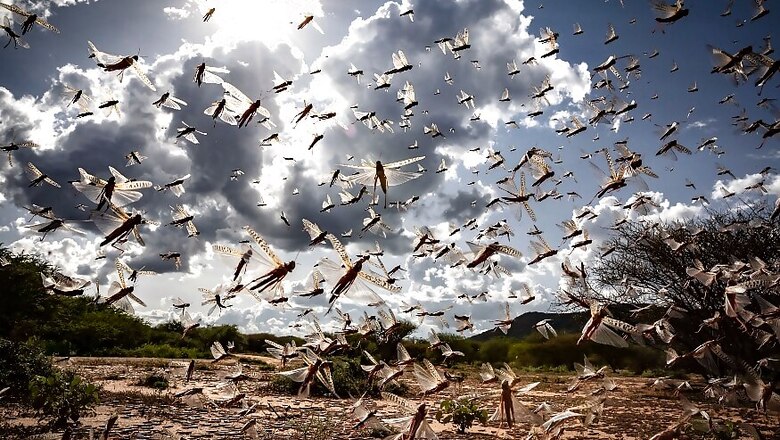
views
Locusts are a cause of concern as they grow at an exponential rate and destroy crops. Many countries and regions are reeling under the threat of locust and its adverse impact on food security. According to the Food and Agriculture Organization (FAO), locust invasion has caused an unusual threat to food security and livelihood in parts of East and West Africa, South West Asia, and India.
Locusts are like grasshoppers, but they can flock into insatiable swarms when in the gregarious phase. Desert locusts have been known to be destructive and damage agricultural production. Locust plagues are known to cover one-fifth of the earth’s surface, threatening the livelihood of one-tenth of all people. An overview of the locusts outbreaks in Asia and Africa tells us how the locust swarms originate from various breeding grounds and are migratory in nature. A single swarm can contain up to 80 million locusts, with a capacity to fly up to 100 km in the direction of the wind. A swarm flew from northwest Africa to Great Britain in 1954 and another from West Africa to the Caribbean in 1988. They are voracious eaters and can eat their weight in plants each day.
Locust Watch has identified three hotspots for locust threatening activity—the Horn of Africa, the worst affected as swarms increase in Ethiopia and Somalia and spread to other countries within a 200-km radius; the Red Sea, affecting the Sudan-Egypt border, originating at the Indo-Pakistan border; and Southwest Asia, causing damage in Iran, India and Pakistan. Rains and spring could cause a widespread increase in locust numbers in East Africa, Yemen and Iran.
The map indicates the Global Forecast for desert locust (May-July 2020). It indicates the threat to agricultural production in east Africa, the Indo-Pakistan border area, Sudan and Sahel in West Africa from spring breeding areas. The swarms are maturing and laying eggs in Kenya and Ethiopia, also spreading to Somalia. The threat is likely to increase this month due to rainfall and spring breeding in East Africa. In the Southwest Asia region, the migration from Baluchistan has begun and groups of swarms have been seen in Rajasthan, India.
This is another challenge for India and the African continent amid the Covid-19 pandemic. It is a “two-front war” against the infection and to ensure food security. A swarm of 40 million locust can eat as much food as 35,000 people, 20 camels or six elephants.
According to a UN joint statement, “East Africa is a region beset by climate- and conflict-related shocks. Millions of people are already acutely food insecure. Now they face another major hunger threat in the form of desert locusts.”
It is time to act more decisively or risk spending 15 times more to feed those whose food crops have been destroyed than to prevent the swarms from breeding. The desert locust breeding in East Africa, Yemen and Southern Iran will seriously increase the threat to food security in the Afro-Asian region.
As per the World Food Program, the world is on “the brink of hunger pandemic” and could face “multiple famines of biblical proportions within a short few months”. About one in nine people (821 million) are hungry, accentuating the challenge of achieving the goal of zero hunger by 2030. Hunger is on the rise in Africa and Asia, along with a high prevalence of undernutrition.
To add to these woes, there are 135 million acutely food-insecure people in 55 countries and territories, according to the 2020 Global Report on Food Crisis. More than half (77 million) are in 22 countries in the Middle East and Asia, Lake Chad Basin, Central Sahel, Horn of Africa and Southern Africa and Central America. The latest analysis by the World Food Programme finds 130 million more people being pushed to hunger due to the Covid-19 pandemic. This adds to a total of 265 million food-insecure people who require food and nutrition assistance as they have very limited or no ability to survive the health and economic consequences of the crisis.
The locust infestation in East Africa and India could aggravate with the monsoons, which creates a favourable environment for them to breed. Food insecurity is already prevalent in these regions, and the locust further threaten food security and access to pasture for livestock.
According to the World Bank, about 23 countries—nine in east Africa, 11 in North Africa and Middle East, and three in South Asia—have been affected by locust. This is the worst crisis to happen in 25 years in Ethiopia and Somalia, 26 years in India, and 70 years in Kenya. A recent assessment report from Ethiopian government and the FAO on the locust situation estimates damage to 200,000 hectares of crops and cereal loss of 356,000 tonnes. This is adding to the rise in numbers to the already estimated 8.5 million people suffering from acute food insecurity in Ethiopia due to the double crisis of locust and Covid-19.
Pakistan is experiencing the worst locust infestation in 20 years and has declared it a national emergency to protect crops and farmers.
In India, the locusts have struck Rajasthan and Gujarat and destroyed nearly 1.7 hectares of farmland. Punjab and Haryana have also reported a presence of locusts since April 2020. According to experts, locusts breed in rainwater and areas hit by cyclone. Climate change has played a role in worsening the locust problem in India, which could worsen with temperature soaring in the coming months. A change in cyclonic invasion and unexpected rainfall leads to locust invasion and breeding.
The Rajasthan government has requested the Centre for INR 200 crore in assistance to cover the losses incurred by farmers due to locust swarms. According to the agriculture ministry’s Locust Warning Organization located in Jodhpur, Rajasthan, it is a time of concern as locusts have been sighted earlier to their breeding season (July-October) in India. They can have devastating effects on the Rabi crop in Rajasthan and Gujarat. Efforts are on to invest in spraying equipment and drone-based locust control strategy to evade a locust attack, especially at the vulnerable Indo-Pakistan border.
The combined crisis of Covid-19 and locust is a big threat and could lead to further disasters such as famine, disease and increased poverty. The loss of agriculture produce, discontinuity of supply chains, labour losses, and the disruption of wholesale markets and transportation due to the lockdown have had a disastrous impact on the economy. The closure of borders as part of quarantine measures have posed limitations on the movement of possible aid to tackle the locust problem.
This calls for an integrated approach with improved monitoring, surveillance and investment in a preparedness plan to make vulnerable nations more resistant to locust threats. There is a need to provide social protection like insurance to farmers and producers through effective governance.


















Comments
0 comment